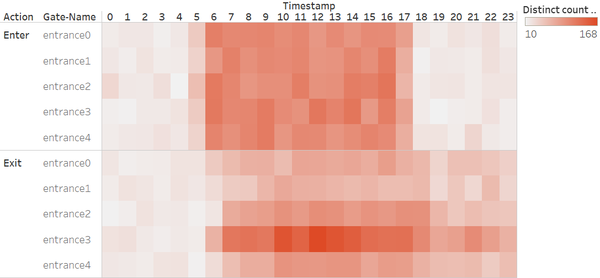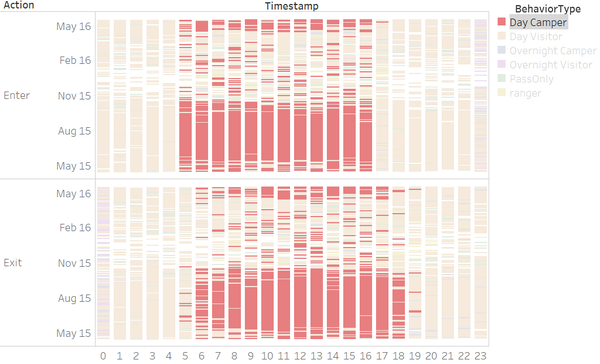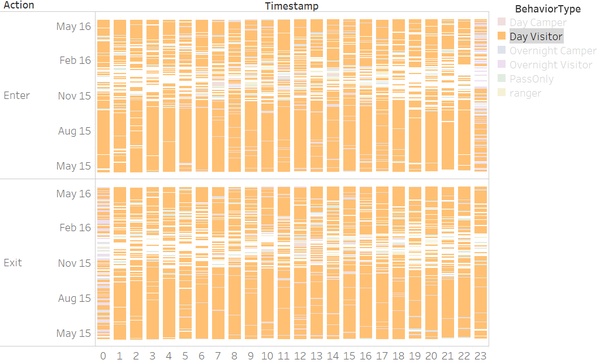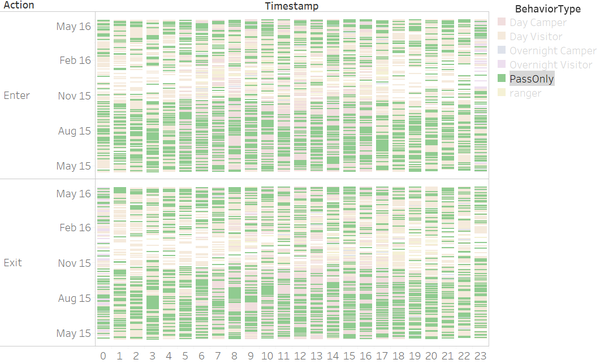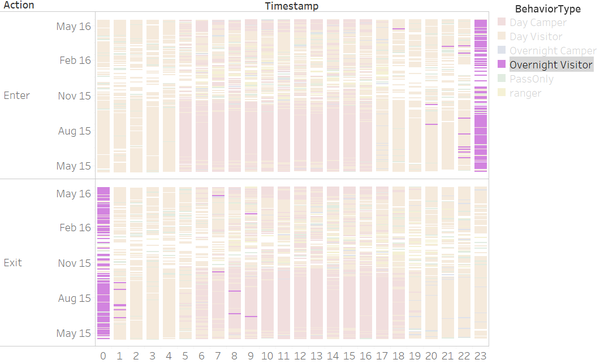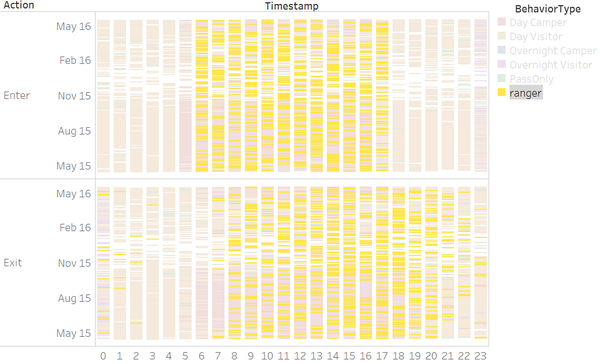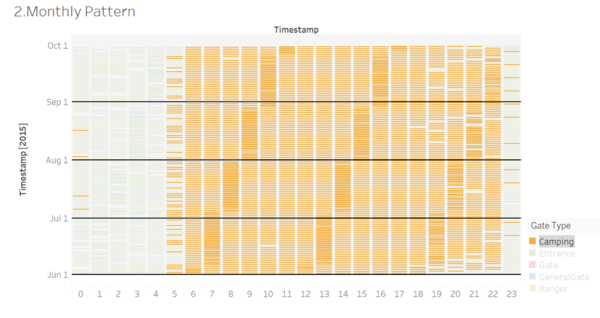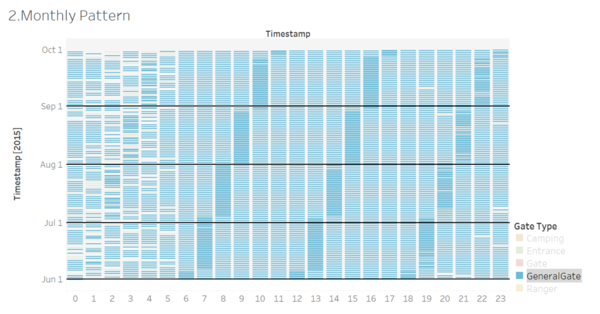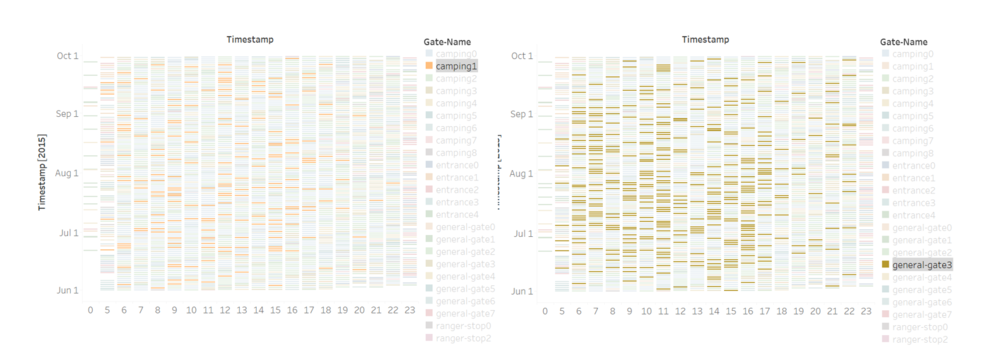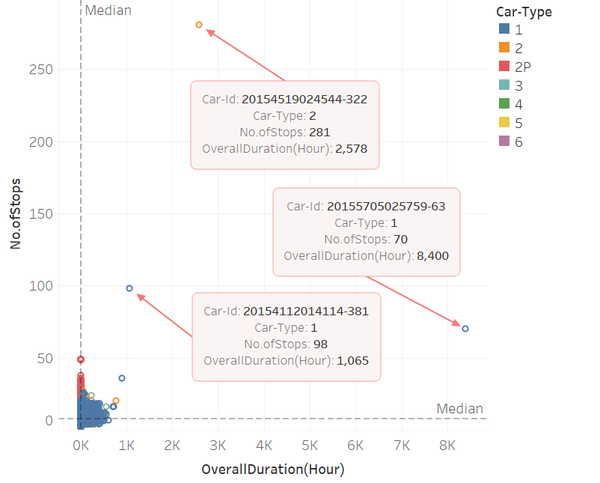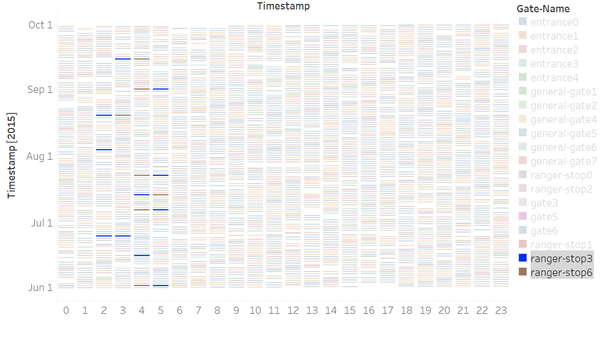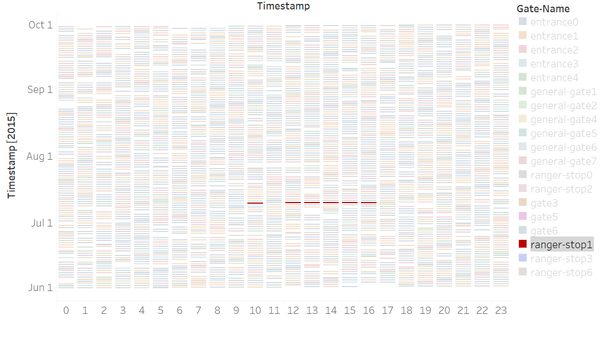ISSS608 2016-17 T3 Assign ZHOU YUHUI Visualization
|
|
|
|
|
Online Dashboard
Question1
“Patterns of Life” analyses depend on recognizing repeating patterns of activities by individuals or groups. Describe up to six daily patterns of life by vehicles traveling through and within the park. Characterize the patterns by describing the kinds of vehicles participating, their spatial activities (where do they go?), their temporal activities (when does the pattern happen?), and provide a hypothesis of what the pattern represents (for example, if I drove to a coffee house every morning, but did not stay for long, you might hypothesize I’m getting coffee “to-go”). Please limit your answer to six images and 500 words.
1) Entrance Visitor Flow:
Cars of Type 1,2 and 3 usually enter the preserve park between 6AM to 5PM during day time, and they do not have strong preference for any specific entrance. Yet when they exit, there are obviously more cars taking exit 3, from 6AM all the way to 12PM.
2) Day Campers
“Day Campers” are those who enter and exit the park within one day with camping activities. These cars start entering the park from 5 AM and stop entering the park at 5PM. All of them leave the park at around 7 PM.
3) Day Visitors and Pass Only
“Day Visitors” are those who enter and exit park within one day without any camping activities, but have more checkpoints than just 2(enter and exit). “Pass Only” are those only have 2 checkpoints – enter and exit. Both of the two groups of cars enter and exit the park basically anytime. The Day Visitors might come for any reason: enter at 3 AM for sunrise, 3 PM for sunset or 9 PM to see the stars.
4) Overnight Camper
“Overnight” Campers are those stay in the park overnight with camping activities. They They usually enter the park from 6 AM to 5PM and leave the park the next day from 6AM to 0AM.
5) Overnight Visitor
“Overnight Visitors” are those who stay in the park overnight and have more checkpoints than only 2. The majority of them enter the park after 11 PM and leave the park within 2 hours, yet a few of them might come earlier and stay a bit longer, leave at about 8 AM next morning.
6) Ranger
Rangers are separated from visitors/campers. They are all “2P” cars and they usually start their journey in the park from “ranger-base” instead of any of the entrances. They start working anytime during the daytime which is 6AM to 5PM and end the work on the same day. But it sometimes happens that they need to work overnight and go back to ranger-base after 23:59PM.
Question2
1) Overview: Calendar graph
From the calendar graph we can tell that from June to September, it is the peak season for this preserve park. Especially in July, the highest daily customer flow could reach 247 cars per day.
2)Monthly Pattern: Daylight Saving Time
From the Gantt bar chart it can be seen that: In June, the most active hours are 7AM, 1PM, 7PM; In July, the most active hours are 8AM, 2PM, 8PM; In August, the most active hours are 9AM, 3PM, 9PM.
There is a time lag of exactly 1 hour across the three months, and this only happens in June, July, August and September. This might have something to do with the “Daylight Savings Time” which would cause a time difference of one hour.
3)Weekly Held Summer Camps:
Zoom in on the Gannt bars we can find that there are small groups of bars which are more compact than other bars, appearing regularly from June to September. Look at these small groups of bars, you will find they happen exactly once a week. And this kind of pattern happens to a few gates only. For example, general gate 4 and 7, ranger-stop 0 and 2. For others like camping1 and general gate 3, there is no such a thing. This might be some weekly event held by organizations. That’s why on these days there will be more people in this park and passing same gates at same time.
4)Season-sensitive Visitors
It is quite obvious that the campers are very season-sensitive. Both “Day Campers” and “Overnight Campers” prefer to do camping from June to October. Very few of them come from November to April.
5)Not Season-sensitive Visitors
Compared with the campers, visitors and “pass only” people are much less season-sensitive, despite that there is slightly smaller number of them from November to April.
Question3
1. No.of Stops vs Overall time spent
There are 3 Car-IDs whose No. of Stops or Overall Duration is suspicious. They all stay in this park more than 1000 hours, which is about 42 days, more than one month. Some of them even reaches 8400 hours, which is 350 days, almost a year. And they go to too many stops as well.
2. "Gate" Visitors at night
There are several records that visit Gate at late night, 1AM-5AM, which is very suspicious. These are not ranger cars, which means they should not be passing by any Gate as Gates are for rangers only.
3. "ranger-stop" Visitors at night
There are several records that visit Ranger-stop3 and Ranger-stop6 at late night, 1AM-5AM, which is very suspicious. These are not ranger cars, which means they should not be passing by any Ranger-stop(other than ranger-stop0 and ranger-stop2) as these ranger-stops are for rangers only.
4. "ranger-stop" Visitors during daytime
There are several records that visit Ranger-stop1 during day time, which is also a bit suspicious. These are not ranger cars, which means they should not be passing by any Ranger-stop(other than ranger-stop0 and ranger-stop2) as these ranger-stops are for rangers only.

